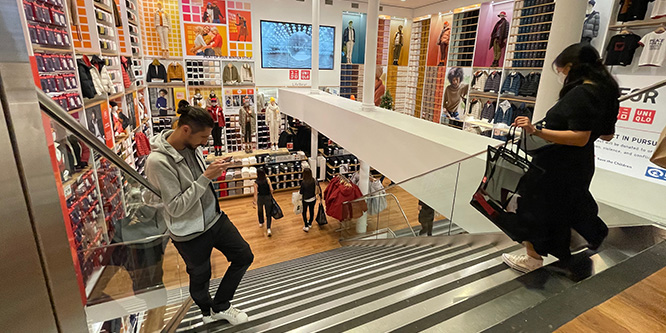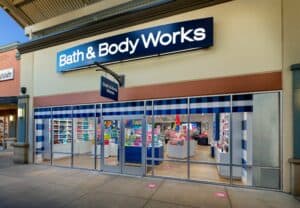
Photo: RetailWire
February 16, 2023
What’s holding back merchandising execution?
A lack of planogram compliance and ineffective localization continues to complicate the merchandising process. Further exacerbating these challenges is the proliferation of shopping channels, more digitally adept shoppers and those shoppers’ rapidly changing preferences, according to a recent study from Coresight Research.
The findings come from a survey of 222 North American retail merchandising decision makers taken last fall that identified five key challenges in merchandising planning and execution:
- Inability to showcase relevant products and execute promotions: Recommendations for retailers included focusing on digitizing planograms to enable a single, standardized source across stores and rectifying anomalies in real time.
- Inefficient planning capabilities: The authors advise working on a centralized platform to eliminate silos and using technologies to access SKU-level information across the store base.
- Labor inefficiencies: Suggestions for cost savings included optimizing staffing levels and using a centralized training portal.
- Inability to fully leverage advanced technologies: Among the recommendations were implementing solutions that would not require a technology overhaul if upgrades are required for a specific area, as well as adopting technologies that have synergies with the existing infrastructure.
- Ineffective localization: Equipping store associates with digital tools to carry out merchandising tasks such as planogram resets, as well as ensuring the traceability of all merchandising instructions at the store level was recommended.
RSR’s recently-released “Merchandising Report” done in partnership with RetailWire BrainTrust contributor and co-founder of Retail Strategy Group Liza Amlani, found 93 percent of retailers think that they can keep pace with shifts in consumer demands — specifically for localized assortments — but 58 percent are hamstrung by an over dependence on data to make effective decisions about which products to sell. When asked about plans for new merchant tools, the biggest opportunities were found to be the integration of automatic replenishment, demand planning and product lifecycle management.
RSR’s recommendations included incorporating customer insights or integrating systems altogether. RSR’s study stated, “The best place to start is not by trying to achieve a ‘personalized’ experience (in the traditional 1-to-1 definition of personalization), but based on … offering relevance.”
Discussion Questions
DISCUSSION QUESTIONS: What are the newer and classic barriers to merchandise execution? Which merchandising tools or solutions offer the most promise?
Poll
BrainTrust
Richard Hernandez
Merchant Director
Ken Morris
Managing Partner Cambridge Retail Advisors
Liza Amlani
Principal and Founder, Retail Strategy Group
Recent Discussions







From all my store visits and chats with shop floor staff, the biggest barrier that remains is having too few staff to merchandise and recover. This is especially acute in larger stores like Macy’s and J.C. Penney — which is perhaps why their shop floors are, all too often, an atrocious mess. You can have the best plans and schemes, but if you don’t put resources behind it then execution fails. A lack of training is another factor frequently mentioned.
Neil, your photos of merchandising disasters are priceless. Keep them coming!
It is hard to tell which of these is the key issue. There is a need to shorten the concept-to-market process, or what has been called “the product lifecycle.” This continues to be a challenge as long as so much manufacturing takes place not just off-shore, but in countries that may not be so friendly to the U.S., or unable to react to unexpected world, climate, and environmental events. In this case, logistics tools are critical. There is also a need for localization and that requires very accurate inventory, sales data and the engines to process these data to produce more accurate local assortments. But this is not all…
Right now, from experience, it’s got to be labor. Staff is wearing multiple hats and you hope you can keep some compliance when planning or up-keeping displays.
The classic barriers to execution remain largely unchanged (although amplified as a result of shifting consumer behavior and the afterglow of the pandemic): Labor, Logistics, and Legacy Systems.
Labor: Not only are retailers challenged to hire open positions, there is difficulty re-skilling current staff to fill new roles.
Logistics: Moving product through the supply chain and then from the backroom to the shelf is an age-old problem that requires new thinking. Speeding up broken processes merely makes them faster, not better.
Legacy Systems: From demand planning to planogram versioning, digital toolsets to compliance monitoring, it’s time to replace the old, outdated systems with solutions that address today’s issues.
In general, there’s a tendency in retail to “try harder” (further automate, optimize existing methods) as opposed to “try differently.” As an example: good inventory positions are critical, so redouble efforts to enforce disciplines, improve systems, do more cycle counts — or maybe instead use computer vision and machine intelligence to very simply see and report what the in-stock positions really are.
While doing the same thing better is the tried-and-true approach, pure test, learn and innovate — a completely different approach — is particularly difficult in retail where SOPs get hardened to allow for scale and cost efficiencies. For doing hard things like properly planning and executing localized assortments we need an equal measure of better more intelligent automation, and pure innovation. For the classic example of the benefits of lateral thinking try googling “Gordian knot.”
Your take on “try harder” versus “try differently” is brilliant!
The key to merchandising success is to embrace art meeting science. Leveraging technology will help break through barriers grounded in inventory management. This will drive smarter assortment planning. Integrating customer insights, innovating processes and automating will help merchant teams focus on innovation and getting closer to the customer. More supply does not equal more demand. Retailers need to rethink their merchandising strategy to be more customer-focused with the right product at the right time and in the right place.
You’re so right, Liza. It is time for retailers to rethink their merch strategy. Wishing the hands of time could be turned back is a disastrous approach.
One of the most significant issues, in my experience, is a lack of understanding of the physical layout and fixture configuration of the stores. The model of integrating planograms with replenishment is spot on. But for it to work, the planogram must accurately represent the fixtures in each store. The more stores a retailer has, the more room for error there is in this process. CAD layers with fixture configurations are great, but they lose accuracy as stores remodel, local managers make changes, or any number of things happen. In stores or departments where fixtures are movable and configurable, the problem is quickly compounded.
The other issue is planogram automation. Creating store-specific planograms for larger chains with thousands of stores remains a challenge despite advances in technology. The result of these issues are store team members being asked to set a display that doesn’t quite fit the physical space where they’re asked to set it. So they’re forced to improvise. And that’s where compliance issues start coming into play.
As we get better with in-store mapping and using tech like RFID to keep track of specific types of fixtures and their configuration and then using technology to tie planograms to the fixtures, this enables a more accurate profile of fixture capacities, product placement, and store layouts. This makes it easier for store teams to set planograms accurately and improves compliance and fulfillment.
This article has me shaking my head. Dependence on technology numbed the merchandising process. Where are the merchants? The people who can put together assortments based on talent and knowing their customers? Where are the visual merchandisers who can turn a pile of product into a beautiful and shoppable display?
Planograms are a wonderful tool — I know, I ran a planogram department for a franchise chain for years, setting displays physically and then using SpaceMan software to create the schematics. SpaceMan was a tool, merchants still built the assortments and created the displays. But planograms only help so much and can remove local flavor from the sales floor.
Walking through stores today shoppers are faced with messy racks and tables of questionable assortments that end up on even messier clearance racks. So I ask again, where are the merchants who can work retail magic using talent and intuition, who can make merchandising decisions without relying on data? Turn them loose. They can’t all be working for independents.
Merchandising is more than just the final in-store execution of merchandise presentation. It also includes the product development process. I would have said that the final execution of a planogram is the easy part — if the product development stage of the process is set up to embrace all of the important variables. In a post holiday floor set, does a Boston store get the same content as a Miami store? I sure hope not. It might not have to be 100 percent different, so what can be shared across multiple regions and what has to be curated to recognize regional differences? All within the same footprint? It’s the complexity of managing all these different moving parts that make it so difficult. Centralizing and standardizing don’t equate to cookie cutter solutions. It means there is a grounding logic to the whole process that recognizes the boundaries imposed by physical fixtures while allowing for the regional differences that need to be addressed.
I am a big fan of both RFID and video analytics. It is critical that a retailer has real-time insight into all their stores—and their other channels, if they have them. We need to be able to look everywhere, all at once and treat the chain like it is one store that we are managing and do it with a vision into every item, in every aisle in every location (for physical stores, anyway). The technology exists, we just have to have the foresight to implement it.
This single-truth view is essential to the multichannel way that shoppers see the world, too. The pre-pandemic world was built only for in-store shopping and online shopping, which were totally separate. Now, merchandising needs to be built around the shopper, ideally around the shopper’s cell phone location!
Technology today can be incredibly efficient in understanding local, store-level demand, deciding what should be on a merchandising display taking into account local products and demand patterns. Add to this the ability to link to supply chain solutions that understand the delivery of merchandise and staffing levels, and the best retailers can really improve merchandising and deliver the very best experience for customers. Staff shortages often come from poor staff planning, not understanding the different jobs that need fulfilling and how this is impacted by supply chain and sales floor activity. Technology today does not live in isolation but works with the other solutions to optimize staff performance and deliver great customer experience.
As others here have alluded, frontline enablement is a crucial piece for modern merchandising execution. Teams are consistently understaffed, onboarding is costly both in terms of time and resources, and to top it all off shoppers are flooding back into stores.
Intuitive and mobile-first solutions that make in-store execution as simple as possible for overloaded teams can go a long way toward improving on-shelf availability and planogram compliance.
In-app ordering and returns, real-time item management, automated tasking/communication, photo AI, and streamlined proof of performance are becoming must-haves for today’s in-store teams. Ideally, these features can be unified into one solution so that teams do not have to jump between apps or rely on texts, emails, and other disorganized processes.
Empowering frontline teams to execute quickly and compliantly = consistently better in-store experiences for shoppers.
Merchandise execution suffers from poor planning. As a root cause, too many retailers rely on Excel spreadsheets for planning — from demand planning to promotion development and campaign management. Although many say labor plays the key part, most retailers can’t hire new folks because their modeling is wrong, their demands are off and they don’t have the extra capital from inefficiency. It’s a vicious cycle. Retailers need to commit to better planning tools and timeframes which can help optimize workforces down the road.
Yes, labor is a big issue, but all supporting technologies are not working together or advancements in adopting these technologies are fragmented. When executing a planogram at the store, it’s a “plan” and might not match up to store conditions which could have changed from the last survey done years ago. Also, surveys or real shelf conditions to match performance do not sync up. Therefore, when bad data is going in, what do you expect to come out? When technologies like robots and fixed cameras are implemented at scale, and better plans are produced, this should minimize the stress on labor and free them up for planogram execution and other tasks. You never know, by then, robots might grow arms and would be able to stock shelves.
In speaking with HQ Retail Ops folks, field teams, and store team members, there are 2 major issues still impacting retail: 1) Planograms, look books, emails, task assignments are not sufficient to show busy/overworked store team members “what good looks like” and enable them to easily deliver so very often they just wing it or worse do nothing. 2) Team members are not incented to care and when incentives do exist, they are generally all “stick” and no “carrot.”
eCommerce has transformed into a fast-paced, non-stop complex industry, operating continuously. New products, seasonality, inventory levels, and prices are changing rapidly, as are consumer tastes, online reactions, and purchasing trends. The globalization of the industry expands stores across borders and currencies, which adds to the complexity. Merchandisers are managing many channels and staff members with varied skill sets. Myriad systems and a host of apps can lead to potential errors which are transparent to everyone. Upset shoppers can taint the brand quickly. Automation frees merchandisers to do more meaningful work and apply smart techniques like personalizing the customer journey, optimizing search merchandising (aka searchandising), and visual discovery. Merchants can stay ahead by instantly reading and acting on every signal, dynamically defining and altering collections, and matching their needs with the buyer’s opportunity.